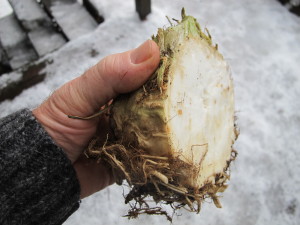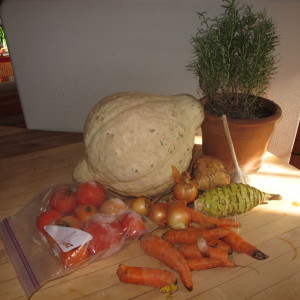Groundhog (Day) Soup
The old timers say that on Ground Hog Day we should still have half our wood supply – or more. This year I had more than half as it’s been a warm winter. Or perhaps not a real winter at all. At the half way point I always want to still have plenty of vegetables left from the summer, and I do. To celebrate Ground Hog Day this year I made a soup of my own vegetables, largely with root crops stored in the basement in an old fridge. Here is what I used:
Ground Hog Soup
1 rutabaga, cut in ½ inch cubes
1 kohlrabi, cut in ½ inch cubes
5 carrots, cut in rounds
3 medium-small yellow onions, finely chopped
½ a small celeriac, finely chopped
1 huge garlic clove, finely chopped
5 frozen whole large tomatoes (or substitute a 28 oz can crushed tomatoes)
2 cups winter squash, steamed
2-3 tablespoons finely chopped fresh ginger
1 tsp dried parsley
¼ to ½ tsp dried hot pepper (optional)
fresh rosemary (3-4 sprigs)
1 qt vegetable stock
1 cup cider
olive oil, salt and pepper as needed
To make the soup I began by sautéing the onions in olive oil until translucent. I use a heavy enameled iron pot for this. While the onions were cooking I chopped the rutabaga and kohlrabi into half-inch cubes, and the carrots into rounds. I added a quart of vegetable stock (I could have made my own, but cheated and used store-bought). Then I put in the root crops I’d cut up and turned down the heat to simmer. I added a cup of cider made from my own apples that I’d frozen, then thawed for this.
I’m sorry to admit that my supply of whole frozen tomatoes is getting low and will have to revert to store-bought canned tomatoes before the new crop comes in this summer. I freeze whole tomatoes in zipper bags in September because it is such an easy way to put them up, much easier than canning. Now I just run them under hot tap water and rub off the skins. I let them sit for a few minutes, then chop them up and toss into the pot.
I added some Espelette hot pepper powder – my own that I dried and ground in the coffee grinder – but you can add jalapeno and use more or leave it out altogether. I added dried parsley and fresh garlic, rosemary and ginger at this time, too.
I always have plenty of winter squash. This year I grew 2 large Hubbard squash in addition to many smaller Waltham butternut squash. For this soup I cracked open a Hubbard even though I couldn’t use all the meat from this 10-pound squash all at once. I cut it into many pieces, removed the seeds, and steamed it in a stock pot until it was soft.
I separated the flesh of the squash from the leathery skin with a large spoon and used 2 cups of the meat for this soup. The rest I cooled, then bagged and froze for later. I blended the squash in my food processor with liquid and tomatoes chunks from the soup pot, though you could use chunks of squash in the soup instead. I find pureeing it makes for a nice thick soup.
Last summer I dug my rosemary in mid-September and potted it in a 50-50 mix of potting soil and good compost. I’ve had it in a south-facing window and it has some soft growth as it leans toward the window, but is healthy, overall. I will start increasing the water to it as spring gets nearer. By March it will need twice as much water as I give it now. Three sprigs of this added good flavor to my soup.
A few words about rutabagas and kohlrabi. They are both great “keepers” for winter storage. Rutabaga grows well in full sun and rich, lightly moist soil. They need to be thinned to 8 inches apart early on or else you’ll get big tops and small roots. The flesh is sweet, not bitter the way some turnips can be. It works like potatoes in a soup, but never crumbles apart the way potatoes do.
Kohlrabi comes in purple or white varieties, and both are crispy and fresh either in a salad, soup or stir fry. ‘Kossak’ is a white variety that can be left in the ground all summer, getting huge – 8 inches or more – but not tough. It is designed for winter storage, and I usually grow some. Thin to 6 to 8 inches apart for good production, more if you are growing Kossak.
If you don’t have rutabagas or kohlrabi, you can substitute potatoes and perhaps add something else from your garden. I generally boil potatoes separately when adding to a soup or stew, and add them towards the end so that they are not mushy or crumbly. I bet green beans would be good in this soup, too. Whatever you use, it’s bound to be good. Bon appetit!
Henry gardens and cooks in Cornish Flat, NH. His e-mail is henry.homeyer@comcast.net. Or write him at P.O. Box 364, Cornish Flat, NH 03746. Please include a stamped envelope if you want him to answer a question.




